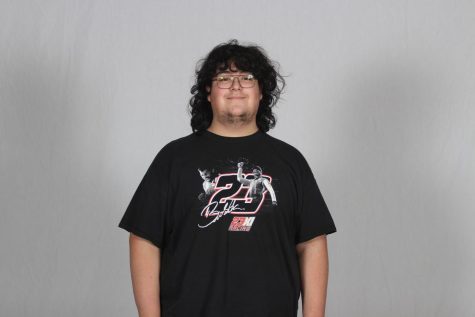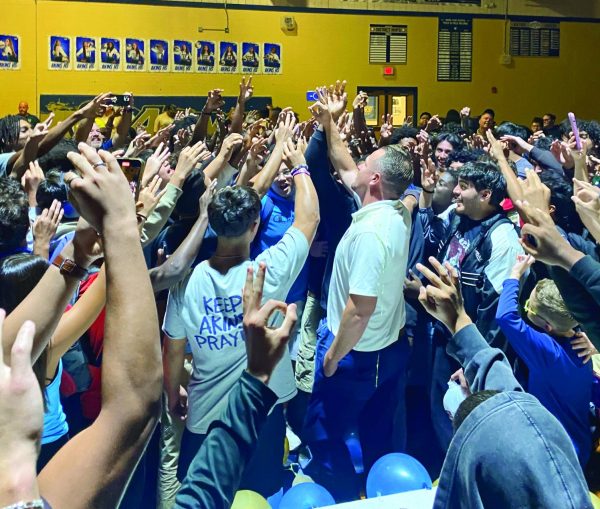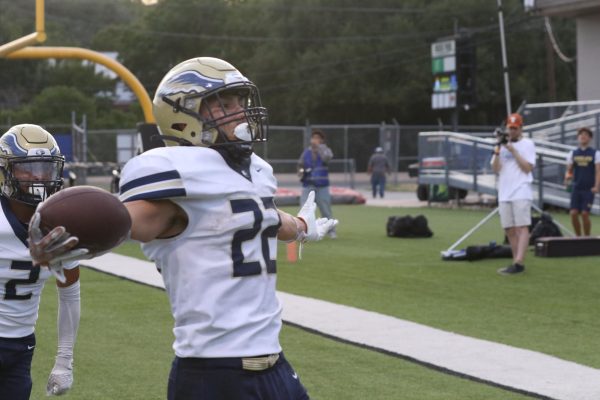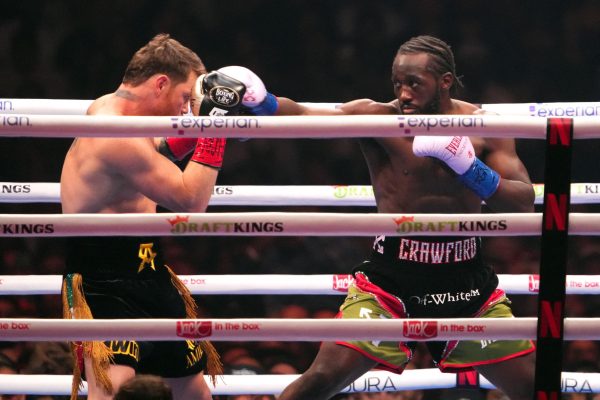Athletic trainers save lives
Importance of athletic trainers takes center stage after recent incidents in the NFL
Athletic Trainer Ann-Marie Reynolds and sports medicine students Assist Junior Matthew Ybarra during the Akins West Lake Football game on September 9, 2022 .
On Jan. 2, the Cincinnati Bengals and the Buffalo Bills squared off for their first match-up for the NFL playoffs. The Bengals immediately hit it off with a strong start in the first quarter with the Bills trying to hit back.
Tee Higgins, the Bengals Wide Receiver, attempted to make a run with the ball in hand, but safety Damar Hamlin powerfully collided with the wide receiver. Hamlin stands back up alongside Higgins, but suddenly Hamlin collapsed hard on the field.
A stadium and a nation watching on television looked on in silence at the scene of what was taking place. Immediately, athletic trainers and medical personnel immediately approach Hamlin to help him. Bills assistant athletic trainer Denny Kellington performed lifesaving CPR on Damar Hamlin on the field for nearly 10 minutes and restored the player’s pulse, before he was rushed to the hospital in critical condition.
Fans are left in disbelief over what was presented in front of them during the game, some of the medical personnel are athletic trainers present at the games of not only national leagues of sports, but also college, high school, or even middle school athletics and even in some cases, little leagues.
Athletic trainers are highly qualified, multi-skilled healthcare professionals who render service or treatment to an athlete. Athletic trainers provide primary care, injury and illness prevention, wellness promotion and education, emergent care, examination, clinical diagnosis, and rehabilitation of injuries and medical conditions.
Junior Mathew Ybarra, an Akins Football Varsity player, suffered a broken wrist during the team’s game against Westlake in September after a collision with a defender. The athletic trainers immediately jumped into action and treated him on the field where he fell.
“Whenever I first got injured I kind of just had like a quick glimpse of my wrist and then I looked back up and I thought that it wasn’t real because for a second I thought I was seeing things,” Ybarra said.“So I looked back down and once I truly saw it, then all the pain started going through my body. And I just didn’t know what to think. So I just went down on the ground I started yelling for help, and I was just like, in so much pain in the moment.”
Ybarra was also asked how the athletic trainers came to his aid when he was hurt.
“Whenever she first got there she didn’t realize what was going on,” he said. “Whenever she asked me what happened, I told her it was my wrist and she looked and then, she went to grab a splint. So that took them about two minutes to get the splint, but all, it took them five minutes to truly treat it and get me off the field,” Ybarra said.
Ybarra said the athletic trainers also helped him with his recovery.
“They helped me recover by just keeping me in the training room making sure I was doing what I needed to do making sure that I did my rehab assignments, and also made sure I wasn’t just slacking and going through the motions. Otherwise it wouldn’t have helped me at all.”
Junior Dee Thompson, quarterback for the varsity football team, suffered from a concussion during the team’s game against Elgin. Thompson said he believes athletic trainers are critical to the care of players who get hurt during games.
“The number one thing is you never know what’s going to happen,” he said.“As we’ve seen with Damar Hamlin, you know, things may not go as planned.”
Recently, the National Athletic Trainers Association released a report that stated that secondary schools with Athletic Trainers are more prepared for sport-related injuries than schools without. NATA president Kathy Dieringer said that only 37% of public high schools across the United States have access to full-time athletic trainers. Over 2,800 Injuries and fatalities were reported by the National Center for Catastrophic Sport Injury Research within its 30-year history, 79% of which were said to be high school athletic injuries.
Among patients with life-threatening injuries who presented to emergency departments, 14% of these injuries have been attributed to sports activities.
According to Athletic Trainer Location And Services reported that out of 20,272 high schools, only 66%(13,473) that were identified, had access to an Athletic Trainer, while 34%(6,799) had no access to an Athletic Trainer.
The Eagle’s Eye asked our Athletic Trainers about these studies. Athletic Trainer Cassandra Campbell responded to both statistics and what she believed the cause was for a third of high schools across the U.S. without Athletic Trainers.
“Athletic trainers often don’t get appreciation and acknowledgment for what they do, or sometimes it is due to budget cuts or lack of access, and sometimes it is due to a lack of awareness of what an athletic trainer provides,” she said.
After the Damar Hamlin incident, sports fans and athletes have an increased awareness of athletic trainers. For example, the Athletic Trainer who saved Damar Hamlin’s life, Denny Kellington, received the NFL’s MVP nomination award.
Cassandra Campbell, one of Akins two full-time athletic trainers, said she has seen other cases where athletic trainers have saved lives.
Athletic trainer Rachel Leahy saved the life of hockey player Eric Huss when he suffered a throat laceration and helped control the bleeding while he received medical attention. Campbell said the Damar Hamlin incident was scary to viewers and health professionals alike.
“What happened with Damar Hamlin is scary, both as a spectator and as a health professional acknowledging that it is something very real that we could experience at work,” she said.
“We hate to see these devastating injuries, these cases are the real-life examples in which athletic trainers are acknowledged for the work that they do,” she said.
Athletic Trainer Ann-Marie Reynolds said she has had to perform CPR on a coach during a game.
“At my last school, I had to do CPR on a coach entirely by myself,” Reynolds said. “Thankfully he ended up surviving, but it is just a testament to why athletic trainers need to be at every single school.”
Reynolds says that if she weren’t there, the coach wouldn’t have survived and that she is thankful every day that she was where she needed to be, and that her training helped save a life.
JP Lopez contributed to this story.
Your donation will support the student journalists of Akins High School. Your contribution will allow us to purchase equipment and cover our annual website hosting costs.

Academy: Stem
Number of Years on Staff: 1st year
Title: Sports Editor
Why do you enjoy being on staff? Being able to write my own articles, and work more with people
What do you do for fun? I watch NASCAR, and F1, and I play music
What are your hobbies? Music video games, and collecting.
Hopes & Dreams after high school? Go to Texas State for Mariachi Program







